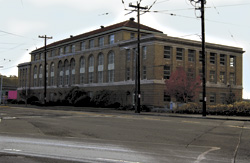White elephants are never free; they have to be underpriced for their bulk so that you think you’re getting a deal. The old INS Building on Airport Way South—east of Qwest Field and the Sound Transit tracks—is the latest such example on Seattle’s development chessboard. Built by the precursor to the Immigration and Naturalization Service in 1931, it was, early on, primarily used for sorting and detaining immigrants (particularly Chinese) prior to deportation. Mothballed three years ago, it’s now vacant, though the basement occasionally serves as a homeless shelter. The four-story building was added to the National Register of Historic Buildings in 1979, meaning it can’t be demolished, enlarged, or substantially modified. Oh, and it’s also full of asbestos. Wanna buy it?
Gallery owner Scott Lawrimore wants you to. He sent out an e-mail blast last week, exclaiming that “A MAJOR opportunity for an arts or culture organization is available” at the building, which is right next door to his space. Lawrimore, who’s openly concerned that redevelopment pressures on the block could push him out, sees great potential in the building, which was designed in the Mediterranean Revival style by James A. Wetmore (whose deco-style old Federal Office Building still graces First and Madison). He said that the city had blown its chances to buy the property from the U.S. government, and that if “some worthy group” would step up in the next week, the building could be had for the low, low price of $1.
The reality is considerably more complicated.
Admiring the building on a sunny Saturday afternoon, as Lawrimore sips soup from Uwajimaya (only steps away), it’s hard not to share his enthusiasm. “Artist studios would be the greatest thing,” he says of the heavily partitioned interior—essentially a warren of offices originally configured for herding and processing poor, huddled masses. He’s one of the few in the Seattle arts community who’s actually been inside the building, which he describes as being in good interior condition. “It’s pretty well lit. Almost every office has a window. As a school model, it would be perfect.” He cites Pratt as a possible fit for the potential classrooms and art studios.
His pink-fronted Lawrimore Project—Seattle’s “it” gallery of the moment—sits just east of the INS Building on a transitional, trapezoidal block controlled by Urban Visions, a real estate company owned by downtown mega-landlord Greg Smith. “We knew going in that this whole area could be redeveloped,” Lawrimore says. He estimates he’s paying rent one-twentieth the going rate in Pioneer Square, but for how long?
True, the city could take title to the INS Building for relatively little money, but only if it kept the building as a monument, says Rick Hooper of the Department of Housing, and made many costly repairs.
Instead, the city invited private developers this year to make proposals for the structure, Hooper says. Only two piped up. Urban Visions proposed a green-oriented hub for architects and designers. An International District group also submitted a plan for “workforce housing,” the current catchphrase for supposedly affordable digs for teachers and cops. Hooper says the city then essentially combined the two proposals for a pitch in which Smith’s company would pay $2.1 million and the city would pay the feds $1 million.
But the U.S. General Services Administration, which manages and disposes of federal property, rebuffed the offer, says Hooper: “They thought they would get more money [elsewhere].” GSA spokesperson Bill Lesh disagrees: “They sent us an unsigned offer, which we declined. We then offered to negotiate with the city. They did not respond to that request.” (Previous bids by two other developers also failed to pass muster.)
What makes the building impossible to pencil out for an arts group is the massive seismic retrofitting that would be required. Sure, you can have the hulk for a buck or two, but then you’ll have to spend north of $20 million (according to an estimate from the ID group) to bring it up to code. Like other old structures built on the former Duwamish mudflats, the INS Building is the kind of financial proposition that invites bulldozing. Says Hooper, “It needs a lot of work.”
This week, according to the GSA’s Lesh, the only decision on the table is whether or not to put the INS Building back on the block for the third time. An affirmative decision seems probable. After that, “the bidding does not have a specified length,” says Lesh. “When the bidding stops, then the auction closes. And, yes, the highest bidder gets the property.”








